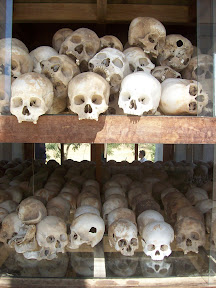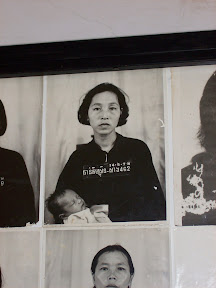The Ghosts of Cambodia
Feb 14-21
As I sit here in Phnom Penh International Airport I wanted to capture my thoughts and feelings about the last week we spent in Cambodia. This won’t be one of my usual lighthearted tales of where we’ve been and what we’ve done; I was deeply affected by Cambodia and just want to share my experience. If you’re not up to reading about one of the most horrific events of the 20th century, then you may want to skip this entry. I was a little nervous about traveling in a country which had been politically unstable for so many years and had only recently achieved peace. I knew of the devastation wreaked by the Khmer Rouge in the 70’s and the tragic loss of life that had resulted from their reign of terror and was unsure about witnessing the results firsthand. In the end, I was glad to have been able to bear witness, not only to the evidence of the horrific crimes committed by Pol Pot and the Khmer Rouge against their own people, but also to the remarkable spirit of the Cambodian people and their ability to rebound and rebuild their lives, families and country in just 25 years.
We arrived in Phnom Penh in the evening and got only a glimpse of the city from taxi on our ride to the New York Hotel, a very nice hotel for only US$35/night. The next morning we hired Doy to drive us around the city in his tuktuk all day for $15.
 |
| From Cambodia |
It didn’t take long to figure out that traffic in Phnom Penh is a scary thing as we veered across several lanes of oncoming buses, tuktuks, cars and about a million motos (scooters). There were almost no traffic lights or stop signs and every intersection was a free-for-all as vehicles weaved in and out across the street. A left turn consisted of turning onto the left side of the street and weaving across the oncoming traffic to the right side. As chaotic as it was, no one seemed stressed or angry as drivers patiently allowed others to merge or cross traffic and we saw no accidents. This type of Aussie rules driving would never fly in North America as drivers would probably end up in fist fights and road rage would become an epidemic. I was glad to leave the driving to Doy as we enjoyed the sights of the city. Our first stop was the Royal Palace
 |
| From Cambodia |
and the Silver Pagoda which had 5000 silver tiles and several jewel-encrusted Buddha’s, the most impressive being a 93kg solid gold Buddha covered in over 2000 diamonds, the largest of which was 25 karats (sorry, no pictures allowed).
Next, it was on to the Choueng Ek Genocide Memorial (aka The Killing Fields), eleven dusty kilometers outside Phnom Penh,
 |
| From Cambodia |
where we were to see the first of several gut-wrenching sights on our visit to Cambodia. If you haven’t seen the movie, this is one of several places in Cambodia where, between 1975 and 1979, the Khmer Rouge performed ethnic cleansing by ruthlessly exterminating anyone who was thought to be a threat to their regime – namely educated people, members of the former regime and even people who wore glasses. It is estimated that over 1.7 million people died at the hands of the Khmer Rouge and another million died of disease, famine and starvation (1/3 of the country’s population). It is believed that 20,000 people perished at the killing fields we visited and our first sight as we arrived was the 8-storey Choueng Ek Memorial Charnal holding the skulls of 8,000 victims who had been discovered there.
 |
| From Cambodia |
 |
| From Cambodia |
Over half of the mass graves have not been disinterred and most of the victims remain in the ground. We hired a young Cambodian guide to tell us about the site and its history. What we heard was bone-chilling and I was glad that the kids got bored and tuned out after the first few minutes. While they played quietly, Claude and I heard gruesome details about how families were separated, imprisoned and brutally murdered by the Khmer Rouge (too gruesome to share here). Our guide pointed out that, as difficult as it is hear the story of the genocide, it is important to keep telling it to future generations in order to prevent the horror from ever repeating itself. After hearing the story, we stopped at the Memorial Charnal to light incense and say a prayer for the victims before walking through the eerie fields. Even though most of the remains have been removed, more are still being heaved from the earth with each rainfall and we could see bits of bones, clothes and even teeth sticking out of the ground.
 |
| From Cambodia |
I felt numb, like my brain couldn’t comprehend the horror, as we walked through this giant graveyard which represented only 1% of the people who had lost their lives in this holocaust.
If that wasn’t enough, after a lunch, Doy took us to the Tuol Sleng Genocide Museum which is a high school that was converted into a prison and interrogation centre by the Khmer Rouge in 1975. It was here that thousands of detainees were interrogated and tortured before being taken to the killing fields (only 7 prisoners ever survived Tuol Sleng). It has been left virtually as it was found with most rooms containing nothing but a metal bed frame, leg shackles and a photo of the victim who was found there.
 |
| From Cambodia |
I had to keep the kids from looking at many of the displays as they were too graphic for young eyes (or my eyes for that matter). The most gripping display, however, was a series of rooms containing nothing but panels of hundreds of mugshots of the prisoners who were detained and eventually murdered.
 |
| From Cambodia |
They included men, women and children (even babies) and looking into their fearful and often defiant eyes was haunting and disturbing because it put a face on the tragedy. The photo that got to me the most was one of a woman clutching her infant with a defeated look on her face.
 |
| From Cambodia |
I had a knot in my stomach by the time I reached the end of the gauntlet of accusing stares and had to wipe away tears before rejoining my family. Finally we climbed the stairs to the second and third floors to see the tiny cells where the prisoners spent most of their days and nights.
 |
| From Cambodia |
Despite the fact that we didn’t let the kids see the more disturbing sights, they were very sober and definitely got a sense of the war and the fact that many people lost their lives. We had struggled with bringing them here but decided that they should have an understanding of the world, both good and bad. We discussed how lucky we were to live in a country where this could never happen (hopefully) and they expressed sadness for people who had died and the children who had lost their parents. At the next temple we visited, Simon was given some lit incense by a monk and, after he had knelt and said a prayer, he came up to me and whispered, “Mama, I said a prayer for all the people who died in the war.”
One of the worst crimes perpetrated by the Khmer Rouge was the destruction of the family. They separated parents, children and siblings, told them that family love was “bad” and encouraged them to turn in family and friends who were traitors to the Khmer Rouge. They “adopted” the children, brainwashed them and trained them to be child soldiers who killed without a conscience. It was these child soldiers who committed some of the most heinous crimes in the name of Pol Pot and the Khmer Rouge. However, once Cambodia was liberated by the Vietnamese in 1979 and the Khmer Rouge’s spell was lifted, these same people demonstrated the power of family as parents and children struggled to find each other and reunite with their remaining loved ones. After hearing these stories, I couldn’t help looking at the Cambodian people in a whole new way. Every time I saw a person over the age of thirty I would wonder what they had been through and how they had survived; I wanted to know their stories. Behind their ever-present smiles, you can almost look into their eyes and see a deep seated sorrow that will never go away. But despite their hardships, the Cambodian people have persevered and are slowly rebuilding their society which was plunged into the dark ages by the Khmer Rouge. They have done so despite losing almost every university educated person including artists, doctors, poets and engineers in the country. In a country where 30% of the population is under the age of fourteen and most live in abject poverty, they have a long way to go, but they are a hardworking, happy people with a tenacious spirit. I’ve gained a deep respect for these determined people who have survived unimaginable horrors and emerged triumphant, if not unscathed.
Let this be a lesson to the rest of us as we live our lives with blinders on – oblivious to what is going on in the rest of the world. Atrocities like this will continue to happen and are happening right now in places like Darfur and Sierra Leone where ruthless dictators are destroying lives and using children as soldiers to fight their battles. We need to support politicians and media who take a stand against oppressive regimes and speak out publicly to denounce human rights violations. As you can see, I was deeply affected by our short time in Cambodia and have made a promise to myself to stay aware of what is going on the world when we return to Canada. We are very privileged to have been born in the West and bear the burden of protecting those who can’t protect themselves. OK, now that I’ve got that off my chest, I’ll get off my soapbox. Thanks for bearing with me.
Tags: Cambodia, Khmer Rouge, Killing Fields, Phnom Penh, South East Asia, Travel, Tuol Sleng

Tam, I enjoy so much reading your eloquent entries. I can’t wait to see you, can’t believe its been 8 months since you left. Eric and I are planning Australia for 2008 – a honeymoon no less.
Love you all,
Kel
Woohoo, it sounds like congratulations are in order! Do I get to be in the wedding party?
Tam
Hear, Hear, Tam
We all need to be blessed with a glimpse of reality now and then.
I love your journals and wish the journey was mine. CI’d like to hear from claude also.